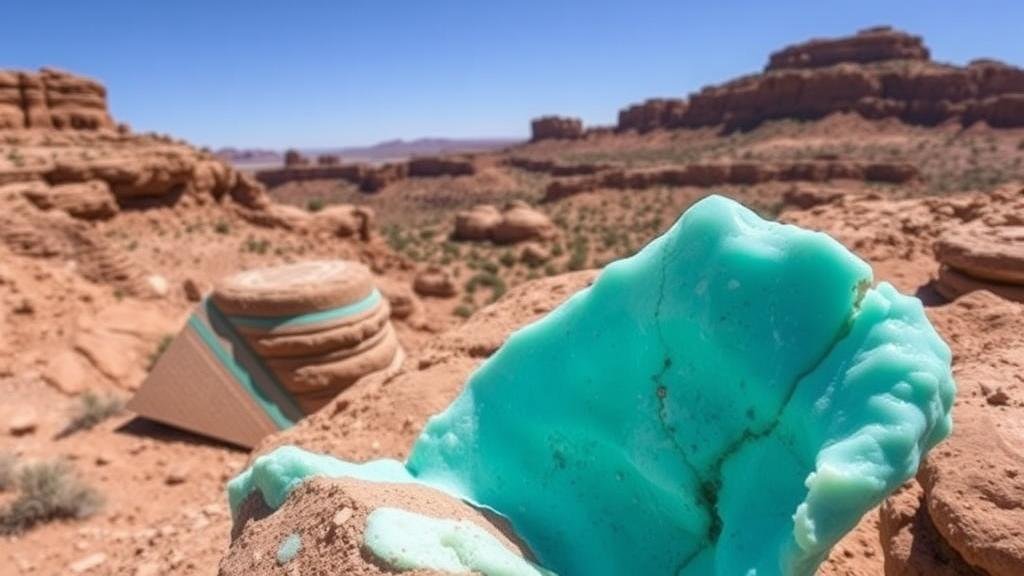Turquoise Traditions: Tracing Ancient Mines in Southwest Deserts
Turquoise Traditions: Tracing Ancient Mines in Southwest Deserts
Turquoise, a gemstone revered for its vibrant blue to green colors, has been a significant part of the cultural and economic landscape of the Southwest United States for millennia. For rockhounds and mineral collectors, understanding the history and origins of turquoise mining in this region offers insight into both its geological significance and its cultural symbolism. This article delves into the ancient mines of turquoise, exploring their historical importance, geological characteristics, and practical tips for collectors.
Historical Overview of Turquoise Mining
Turquoise mining in the Southwest dates back over 1,000 years, with evidence pointing to the Ancestral Puebloans and later civilizations, such as the Navajo and Zuni. These indigenous peoples viewed turquoise not only as a decorative stone but also as a powerful talisman symbolizing protection and prosperity.
The oldest known turquoise mine is located in the Turquoise Mountain region in Arizona, which dates back to around 900 AD. Archaeological findings from ancient dwellings, tools, and processed turquoise artifacts reveal that these ancient miners used rudimentary methods to extract this precious gem.
Geological Significance of Turquoise
Turquoise is a hydrous phosphate of copper and aluminum (CuAl6(PO4)4(OH)8·4H2O) that forms in arid environments rich in copper. Major deposits in the Southwest are often associated with volcanic rocks, particularly those that have undergone oxidation. The formation process requires specific conditions, including:
- A source of copper, typically from nearby minerals like malachite and chrysocolla.
- Silica content to enable the miliolite matrix.
- Alkaline conditions that facilitate the crystallization of turquoise.
Some of the prominent operating mines that mineral collectors often visit include the Sleeping Beauty Mine, Bluebird Mine, and Kingman Mine. Each mine is known for distinct color variations, from lighter robins-egg blue to the darker, richly veined specimens.
Modern Mining Techniques
Todays turquoise mining employs more advanced techniques compared to ancient practices. Modern operations utilize heavy machinery for excavation, while respecting areas of cultural significance. The balance between production and preservation is particularly critical in regions like the United States where regulations are enforced rigorously to protect both the land and indigenous heritage.
One example is the use of open-pit mining which, while efficient, often raises concerns about environmental impacts. As per the U.S. Geological Survey, over 95% of the turquoise produced in North America comes from these modern mines, significantly contributing to both the local economy and collector markets.
Practical Tips for Mineral Collectors
For enthusiasts eager to start their turquoise collection, there are several key factors to consider to ensure quality and authenticity:
- Research Provenance: Understanding where the turquoise was mined can provide insight into its quality and value. Look for reputable sellers who can offer verification of the source.
- Check for Treatments: Many turquoise pieces are treated to enhance their color and durability. Its essential to clarify whether the piece has undergone such processes.
- Inspect Color and Matrix: Authentic turquoise should have a vivid color without excessive crackling or fissures. Natural stones may exhibit some matrix or host rock inclusions, which add to their uniqueness.
- Learn About Collecting Techniques: Engaging in local mineral shows or gem fairs can provide valuable opportunities to learn about authenticity verification, pricing, and care of stones.
Conclusion: Embracing Turquoise Traditions
As rockhounds and mineral collectors explore the history of turquoise, they not only appreciate its aesthetic qualities but also its deep cultural connections. By understanding the geological and historical context of turquoise mining in the Southwest, collectors can make informed choices while respecting the traditions that have shaped the significance of this stunning gemstone.
Collectively, these practices can preserve the legacy of turquoise for future generations and encourage a sustainable approach to collecting. Whether you are a seasoned collector or a curious newcomer, embracing the rich tapestry of turquoise traditions enriches the exploration of this remarkable stone.



